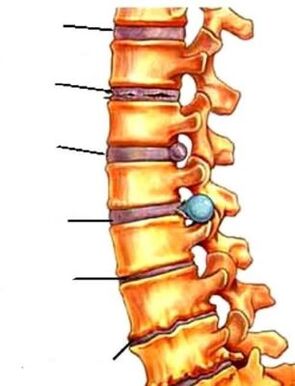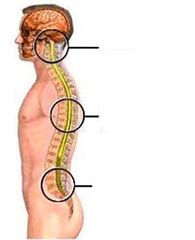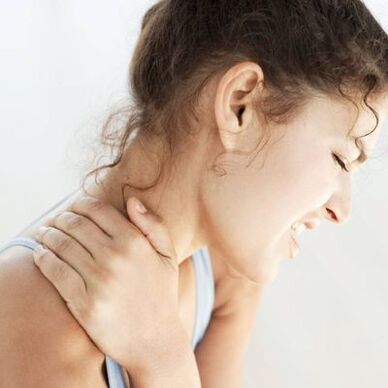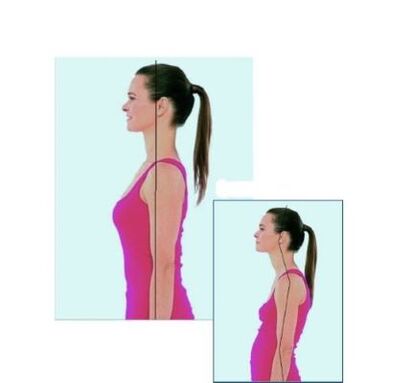Osteochondrosis is a term used to denote a group of diseases associated with degenerative and dystrophic changes in the structure of the spine. First, the intervertebral discs, as the disease progresses, the vertebrae themselves suffer. Degenerative are changes caused by tissue eating disorders, which are changes associated with tissue abrasion, aging, loss of original properties, and dystrophy. Thus, the term osteochondrosis unites most pathologies of the spine and is non-inflammatory in nature.

The spine forms the backbone of the skeleton, connecting different parts of the skeletal system. It supports the head, the ribs and muscles are attached to it. The spinal cord passes through the spinal column, through which the brain connects to different parts of our body. Man is the only two-legged creature in the world, and the spine is designed to provide two-legged movement. Therefore, the spine is curved, reminiscent of the letter S of the Latin alphabet, and is not a rigid rod, but a complex structure composed of elements attached to each other — vertebrae. This structure of the spine allows us to perform various movements, be flexible, and absorb shock and shock. The function of the shock absorbers is performed by intervertebral discs - cartilage layers consisting of the nucleus pulposus and the surrounding annulus fibrosus. The core absorbs the load and absorbs it, and the annular fibrosus prevents the core from flattening under pressure.
Decreased resilience of intervertebral discs may become the beginning of a wide range of problems. Because it cannot withstand the load, the intervertebral discs begin to deform, and the spine loses its proper shape. The progression of the disease leads to further destruction of the intervertebral discs, the fibrous ring breaks, the vertebrae making hard contact with each other, allowing the nerves connecting the spinal cord to different parts of the body to be pinched. This is how osteochondrosis develops. Intervertebral hernia occurs and inflammation often develops. Deprived of shock absorption, the vertebrae can flatten and their joints together form cicatricial and bone growth.
Osteochondrosis is one of the most common diseases. Only cardiovascular disease is more common. According to some estimates, every second inhabitant of the planet suffers from osteochondrosis. Osteochondrosis is more common in women, but its manifestations are more painful on average in men.

What is osteochondrosis
Osteochondrosis affects different parts of the spine. Depending on which class suffered the most, there are:
- lumbar osteochondrosis - most common;
- neck - in second place in "popularity";
- sacred;
- chest;
- widespread osteochondrosis in which several parts of the spine are affected simultaneously;
- cross pathologies (lumbosacral or cervicothoracic).
Causes of osteochondrosis
The causes of osteochondrosis are quite varied.
First, as age advances, the elasticity of intervertebral discs gradually loses. This means that special attention must be paid to our backs. Prolonged residence that causes spinal distortion can cause irreversible changes. You should avoid sitting in an asymmetrical position, struggling with the habit of lying on one side only, carrying loads (such as a bag) in only one hand.
A sedentary lifestyle has a detrimental effect on spinal health. Exercise is required, however, physical activity should be moderate. The spine should be given the opportunity to recover from the load, and it is advisable to avoid injuries that also lead to the development of spinal pathologies.
The second group of causes is metabolic disorders and malnutrition. Foods rich in carbohydrates and fats saturate the body with calories that we often have nowhere to spend in our sedentary city life; as a result, the energy is deposited in the form of adipose tissue, which creates excess weight. Obesity is an increased load on the spine that leads to the development of osteochondrosis. In addition, such a diet usually does not contain enough trace elements (calcium, potassium, phosphorus, magnesium, manganese, and others) that are so necessary to strengthen bone tissue. Obesity is often caused by endocrine diseases. However, violation of energy, water, or mineral metabolism can also negatively affect tissues involved in the structure of the spine.
Factors that contribute to the development of osteochondrosis may include:
- goosefoot;
- hormonal changes;
- infectious diseases;
- local circulatory disorders,
as well as some other factors.
Symptoms of osteochondrosis

There are no pronounced symptoms in the initial stages of osteochondrosis. The development of osteochondrosis is suspected:
- dull pain in the back (area of the affected area of the spine);
- feeling of heaviness in the back, constant tension in the muscles of the spine;
- numbness of the muscles, the appearance of "goose hills". This is when it is usually said that "your back is numb";
- crackling when turning body and neck;
- headache, dizziness, tinnitus (typically in cervical osteochondrosis);
- painful pains in the chest area (typically chest osteochondrosis).
When such symptoms first appear, it is advisable to have a neurologist examine them.
Further development of the disease is manifested by symptoms that cause significant discomfort:
Back pain
There are severe pains in the back (along the spine). The pain can radiate to the limbs.
Numbness in the fingers
A typical manifestation of osteochondrosis is numbness of the fingers and toes.
Restriction of motor activity
Even with minimal physical exertion, the pain increases (for example, due to shaking and vibration during traffic). Pain leads to significant restrictions on mobility and motor activity.
Methods of diagnosing osteochondrosis
The main role in the diagnosis of osteochondrosis is played by instrumental examinations: radiography, computed tomography, MRI.
It may be necessary to confirm that the symptoms observed are not caused by another disease. For differential diagnosis, general and biochemical blood tests, general urine tests, and ultrasound examinations of internal organs are performed.
Spinal X-ray
X-rays are taken of problem areas of the spine. Which ward should be examined is determined based on the patient’s complaints.
Computed tomography (CT)
Computed tomography (MSCT) makes it possible to obtain a more informative picture of pathological processes and to determine their severity. In particular, MSCT allows the detection of intervertebral hernia.
Computed tomography is performed when X-ray data are insufficient.
Magnetic resonance imaging (MRI)
MRI is the most informative method for diagnosing osteochondrosis. In some cases (e. g. , suspected osteochondrosis of the thoracic spine), MRI cannot be waived. Magnetic resonance imaging allows the visualization of cartilage and soft tissues, allowing the source of problems to be traced as accurately as possible and the cause of the disease to be determined.
Osteochondrosis treatment methods
It is advisable to start treatment for osteochondrosis as soon as possible, as pathological changes in the spine are irreversible in most cases. Therefore, treatment is primarily aimed at relieving pain and preventing further progression of the disease.
The process of treatment is usually complicated and is prescribed individually depending on the patient's condition. The clinic uses it to treat osteochondrosis:
Drug treatment
First, treatment is aimed at stopping (eliminating) the pain syndrome. Anti-inflammatory and muscle relaxants (muscle relaxants) are used.
Medicines that improve blood circulation, chondoprotectors (drugs that restore cartilage tissue), vitamin D, and calcium supplements are also used to treat osteochondrosis.
Massage
Anti-osteochondrosis massage relieves muscle tone, stimulates spinal blood flow and improves metabolic processes. It serves to strengthen the vertebrae and intervertebral discs, suppress inflammation, and reduce pain.
Physiotherapy
In the case of osteochondrosis, physiotherapeutic methods such as electrophoresis, phonophoresis, UHF, magnetotherapy are used.
Reflexology
Reflexology of osteochondrosis is used as an additional therapeutic method. Acupuncture helps relieve pain, reduce inflammation, normalize blood circulation and enhance the effects of medications used.
Physiotherapy

Physiotherapy for osteochondrosis is primarily aimed at relieving pain and restoring spinal mobility. They use a specially selected series of exercises.
Prevention of osteochondrosis
To prevent osteochondrosis, doctors of the clinic recommend:
- maintain the correct posture. Posture is the normal position of the body while standing. Ideally, the head and back should be in the same vertical position, the shoulders should be at the same level, the stomach should retract and the chest should rise. The habit of the body is shaped by the movement of the body, so care must be taken to maintain posture - not to crouch or crouch;
- to lead an active lifestyle, to exercise;
- it is useful to hang on a horizontal bar - while the spine is stretched;
- sleep on a hard mattress. It is advisable to buy an orthopedic mattress and pillow;
- follow a balanced diet, consume foods high in vitamins and minerals.

























